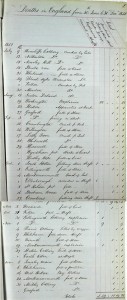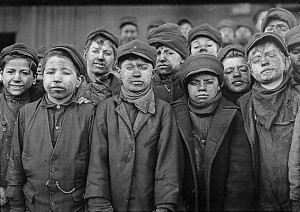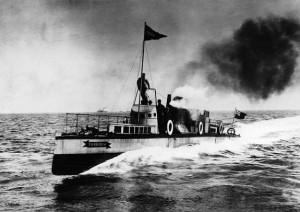Industrial Revolution – Coal Industry Working Conditions Notes
- Worked from dark of the morning to the dark of night
- Many worked in the dark
- Whole families worked in the mines
- Even pregnant women would work underground because they needed money
- Saw sunlight one day a week
- Many deaths (As the coal industry expanded, so did the number of deaths)
- Working was dangerous and had many risks involving toxic materials
- Coal dust (Could cause a disease, Black Lung)
- Lead (poisonous)
- Lime (Can blister or Blind)
- Cave-ins (Roof falls; common)
- Explosions (Which are caused by easily ignited methane gas)
- Flooding
- Gas Pockets (Which could be ignited from a flame or a spark from a pickaxe)
- Fatalities, Respiratory Illnesses were common
- Miners had nothing to protect themselves with
- Some miners used certain methods to help
- Some brought canaries (When they stopped singing that means there was gas)
- Some left columns of coal “Pit and stall” method (Wasn’t the safest because coal collapses easily)
- Ventilation was a problem as the miners went deeper underground
- They dug a down and up shaft and at the bottom of the up-shaft a fire was set ablaze which sent the hot air up and sucked fresh air down
- To make sure the air reached all parts of the mine, trapdoors were used.
- Another serious danger was the need for light
- They used to bring candles but as they went deeper this proved to be dangerous because it could ignite pockets of gas
- 1815 Sir Humphrey Davy invented the safety lamp which allowed miners to have light without an exposed flame because of a wire gauze that acted as a barrier.

Report of miners killed from June 30th, 1850 to December 31st, 1851. http://www.nationalarchives.gov.uk/education/victorianbritain/industrial/source1.htm
Newspaper extract includes deaths and injuries from July 1898 to June 1899. http://www.nationalarchives.gov.uk/education/victorianbritain/industrial/source6.htm
Child Labour
- Many workers hired at young ages
- Child workers were widely used (some age from 5)
- Even child workers were in the dark for over 12 hours
- Older girls had to carry baskets of dug coal which was far too heavy
- Some had to work in water that came up to their thighs
- Caused deformation for young females and was fatal later in life
- Children were exploited and beaten
- 1860; Banned children under twelve from working underground

Child workers from The Coal Mines. http://historylearning.com/great-britain-1700-to-1900/indrevo/coal-mines-industrial-revolution/
Payment
- Paid by amount and quality of coal mined
- Could be fined if there is too many smaller pieces (Slack)
- Children were payed less (around 2 pennies) and instead were compensated with food
Mining Legislation
- Government Reform was slow to take place (People didn’t know the conditions)
- First mines act passed in 1842; Very general, with no provisions for housing or inspection (Did signify Government taking responsibility)
- 1850; Act that allowed for inspection of mines and allowed inspectors to get involved in how the mines were run while also being able to fine owners and report deaths. (Only 4 inspectors at this stage)
- New act in 1855 introduced seven basic rules about:
- Ventilation
- Air shafts
- Unused pits being fenced off
- Proper lining inside
- Better signalling from mine to surface
- Adequate breaks for the steam powered elevators
- Safety rules for stream engines
- 1860 there was permanent legislation to build on previous laws (Child labour)
- 1872 increased the number of inspectors and made sure they had experience in mining before they began
- By the end of the century the industry went from mostly unregulated to having miners represented in parliament as well as starting laws regulating mines.
Crossroads 2nd Edition (Pg. 250)
http://www.saburchill.com/history/chapters/IR/039.html
http://historylearning.com/great-britain-1700-to-1900/indrevo/coal-mines-industrial-revolution/
http://www.nationalarchives.gov.uk/education/victorianbritain/industrial/default.htm
Industrial Revolution – Positive Effects of Steam Power Notes
- Railroad sped up transportation
- Steam power created countless new jobs

The industrialization of the Steam engine created new jobs forcing people to move to cities. http://railroadandsteamengine.weebly.com/impact.html
- Propelled countless industries
- Boosted production and transportation of natural resources (which were vital to society)
- Steam locomotive was a big turning point that changed the business outlook which is present today.
- Steam power brought many opportunities for inventions (E.g. Telephone, Electric lighting, etc.)
- Steam power offered a way to generate power which allowed advancements in technology, manufacturing, transportation, and other fields

Charles Parsons’ Turbinia yacht, seen here in 1897, was the first steam turbine-powered ship. http://www.livescience.com/2612-steam-engine-changed-world.html
- Many things today we would not have if not for the Steam engine
- Spike in population

Industrial Revolution gave way to a huge rise in population. https://mmuntazir.wordpress.com/2011/03/07/industrial-revolution-advantages-disadvantages/
http://railroadandsteamengine.weebly.com/impact.html
http://www.ask.com/history/positive-effects-steam-engine-44b80cbf6a64b594
Leave a Reply